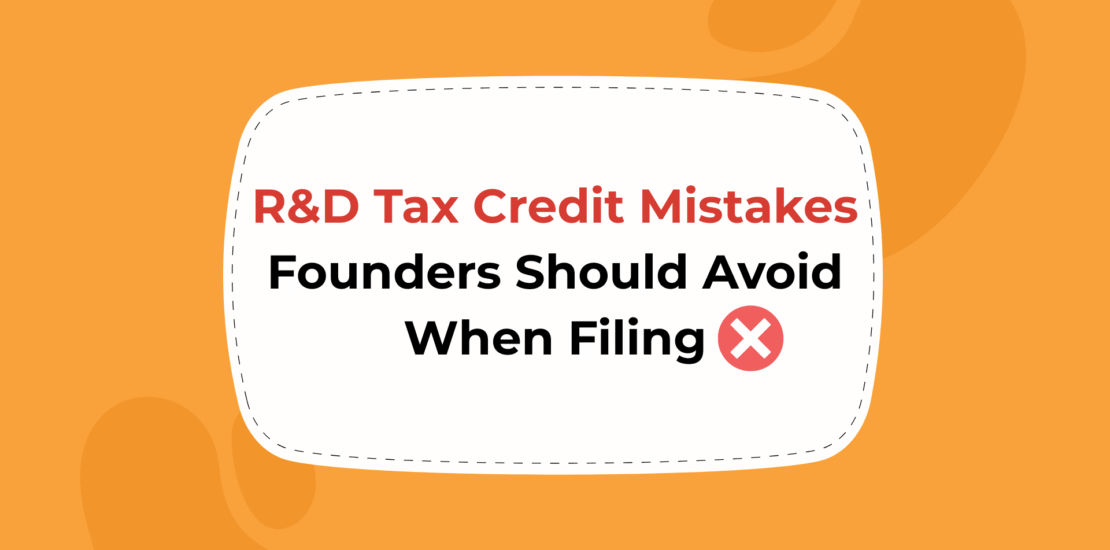R&D Tax Credit Mistakes Founders Should Avoid When Filing
- July 10, 2025
- Posted by: Noushed Shaikh
- Category: Uncategorized

Filing for the R&D tax credit can unlock tens of thousands in cash savings, but only if done right. Founders often miss out due to common R&D Tax Credit Mistakes, like poor documentation or misunderstanding eligibility. This guide helps you avoid those pitfalls and claim your credit with confidence.
This blog outlines the key mistakes to watch out for, enabling you to file your R&D credit correctly, avoid penalties, and receive the full benefit your business deserves.
Common R&D Tax Credit Mistakes

Mistake No. 1: Assuming You Don’t Qualify Without Revenue
Many founders skip the R&D credit because they think it only applies to profitable businesses. But that’s incorrect. If your company is spending money on product development and has U.S.-based employees, your business is qualified for R&D credit. Even pre-revenue companies can claim the credit through payroll tax savings.
Mistake No. 2: Including Non-Qualifying Activities as R&D
Some businesses attempt to include work such as marketing, customer support, or administrative tasks in their R&D credit calculation. These activities don’t meet the IRS requirements. The credit only applies to technical work that aims to develop or improve a product, process, or software.
Mistake No. 3: Missing the Required Documentation
To support your R&D claim, you must maintain records that show what work was done, by whom, and how it qualifies. This includes timesheets, job descriptions, payroll records, and technical notes. If you don’t have these, your claim may be rejected or reduced in value.
Mistake No. 4: Forgetting to File Form 6765 or 8974
Many founders file their taxes but miss these specific forms. Form 6765 is used to calculate the R&D credit. Form 8974 tells the IRS to apply the credit against your payroll taxes. If these forms are missing, you won’t receive the credit even if you qualify.
Mistake No. 5: Not Involving a Tax Professional Early
Some companies try to file the R&D credit on their own. But this can lead to calculation errors or missing documents. A qualified tax expert understands what qualifies and how to document it. Involving a professional early can improve accuracy and reduce the risk of penalties.
Mistake No. 6: Overlooking Payroll Tax Offsets for Pre-Revenue Startups
Founders often think the R&D credit only applies to income taxes. But if you’re not yet profitable, the credit can still be applied to payroll taxes up to $500,000 per year. This helps reduce cash burn even before you generate revenue.
Mistake No. 7: Applying for the Wrong Tax Year
Sometimes, founders attempt to claim the R&D credit for a tax year for which they’re not eligible. For example, if your company is more than five years past its first gross receipts, you can’t claim the payroll offset. Always confirm your eligibility for the right tax year before filing.
Mistake No. 8: Not Keeping Track of Past Opportunities
If you missed claiming the credit in previous years, you can still go back and file an amended return for up to three years. Many companies miss this chance. Reviewing your records and consulting with your CPA can help you recover savings for which you’re still eligible.
How These Mistakes Can Lead to IRS Issues or Lost Savings

The IRS takes R&D tax credit mistakes seriously. Even small errors can drain your cash flow, invite audits, and hurt your company’s long-term growth. Here’s what you risk if you’re not careful:
Risk of IRS Audit
Submitting incomplete forms or including activities that don’t qualify as R&D can trigger an IRS audit. This adds extra paperwork, disrupts your team’s time, and puts your business under unnecessary pressure during a critical growth phase.
Denied or Reduced Credit Amount
If your documentation is incomplete or your expense calculations are inaccurate, the IRS can reject or reduce your credit claim. This can result in wasted time and effort with no financial benefit.
Loss of Eligible Credits
If you miss deadlines or can’t provide proper proof of R&D activity, your business could lose access to thousands of dollars in payroll tax savings that would have reduced your burn rate.
How Is the R&D Tax Credit Penalty Calculated?
Penalties for errors in your R&D tax credit filing depend on the type and intent of the mistake:
- Negligent mistakes can lead to penalties ranging from 0% to 30% of the total benefit or tax owed.
- Deliberate errors that are intentional but not hidden may attract penalties between 20% and 70%.
- Deliberate and concealed mistakes, where false information is knowingly submitted and intentionally hidden, can result in penalties of 30% to 100% of the benefit claimed.
You can often reduce these penalties by voluntarily correcting the mistake. The sooner you cooperate with tax authorities, the better your chances of lowering or avoiding the penalty.
Need Help Filing the R&D Tax Credit Correctly?
Schedule a free consultation today.
At LedgersCFO, we specialize in helping founders and early-stage businesses navigate the R&D tax credit process with confidence and eliminate the risk of R&D Tax Credit Mistakes. From identifying eligible activities to preparing accurate documentation and filing the right IRS forms, we take care of everything.
We work closely with your CPA or finance team to make sure nothing is missed, and you get the full credit your business deserves without the stress of dealing with confusing rules or risking penalties.
Schedule a free consultation today to see how we can help you claim your R&D tax credit the right way and improve your company’s cash flow.
FAQ’S
1.What happens if I file the R&D tax credit with missing documents?
Missing documentation can result in your credit being reduced, denied, or even audited by the IRS. To avoid this, always maintain detailed records like timesheets, technical reports, and payroll summaries.
2.Can I still claim the R&D credit if my company hasn’t made any revenue?
Yes. You don’t need revenue to claim the R&D payroll tax credit. As long as you have eligible research expenses and U.S.-based employees on payroll, you can apply the credit against payroll taxes.
3.What are some non-qualifying activities that founders mistakenly include?
Many founders mistakenly include activities like marketing, customer service, admin work, or routine data entry. Only technical work aimed at solving problems or creating new features typically qualifies.
4.What forms are required to claim the R&D credit properly?
You must file Form 6765 to calculate the credit, Form 8974 to apply it to payroll taxes, and Form 941 or 941-X, depending on whether you’re filing for the current or a previous quarter.
5.How does LedgersCFO help with R&D tax credit filings?
LedgersCFO helps by reviewing your eligibility, identifying qualifying R&D work, collecting proper documentation, and coordinating directly with your CPA or payroll provider to ensure a correct and timely filing.

